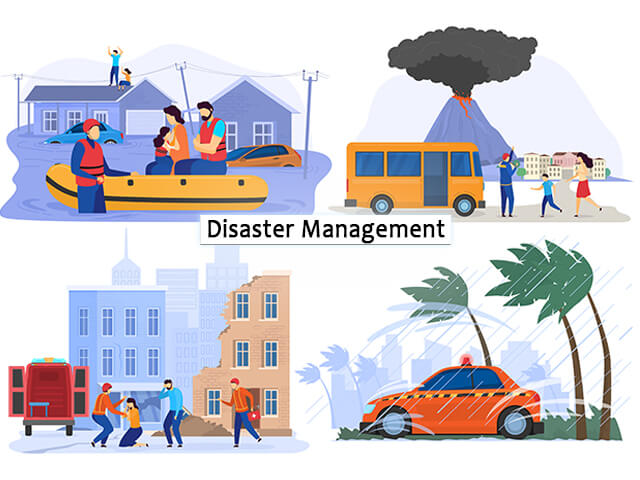Disaster Management
A sudden event that causes large-scale damage to the life, property, and social aspects of a nation or society is called a disaster. The disaster can be categorized into two types Natural or Man-made disasters. Natural disasters include Flood, earthquakes, lightning, Volcanic eruption, and Forest fires. Man-made disasters include Terrorism, Riots, and Crimes resulting in bomb explosions, Assaults, fires, Accidents, etc.
About Disaster Management
Disasters are the result of human activity or sometimes they are just a result of natural calamities we cannot predict them but we can take necessary emergency measures to save and preserve lives. Taking steps to prevent disaster, making plans to face disasters, and developing the capacity for that, is called disaster management.

The geographical condition of India makes India a highly disaster-prone country. On the other hand, India has hostile nations like Pakistan as neighbors hence Terrorist attacks are common in India. India has also seen some communal riots.
Some of the well-known lists of disasters in India are
- In July 2014 the whole village of the main in Ambegaon taluka of Pune district was destroyed in a matter of minutes due to a landslide. Many got buried under heaps of soil and stone and lost their lives.
- In November 2015, a heavy flood occurred in Tamil Nadu due to heavy rain taking thousands of lives
in 1993 many people died due to an earthquake at the Killari in the Latur district. - In July 2005 many people lost their lives in Mumbai due to heavy rains
- The most famous man-made disasters are the 1993 Mumbai bombings and the terror attack of 26/11 on Mumbai.
- Today we are facing the biggest biological disaster covid 19. Fighting covid 19 is just like fighting a world war. Because covid 19 is spread all across the world. The government of India has issued a guideline to wear a mask, wash hands daily, use sanitizer and keep a distance of 2 to 3 meters from other people. Just like covid, there are certain measures for every disaster whether it is a flood or earthquake.
Types of Disaster Management
- Water and climate disaster: Flood, hail storms, cloudburst, hurricanes, droughts, cold waves, heat waves, cyclones.
- Geological disaster: Landslides, earthquakes, tornadoes, volcanic eruptions.
- Biological disaster: Viral epidemics, pest attacks, locust plagues, and cattle epidemics.
- Industrial disaster: Chemical and industrial accidents, oil spills, mine shaft fires.
- Nuclear disasters: Radiation Poisoning, Nuclear core meltdowns.
- Man-made disasters: oil spills, the collapse of huge building structures, and Urban and forest fires.
Causes of Disasters
- Environmental degradation: Deforestation and increasing pollution cause flood, soil erosion, and drought.
- Developmental process: Urbanization is taking place everywhere as a result of which demand for people is also increasing which is increasing exploitation of the natural resource.
- Political issues: There is competition among different countries for supremacy or land dispute which results in war or terrorism is also the reason for the disaster.
- Industrialization: With progress in science and Technology industrialization is taking rapidly all over the world with results in air and water pollution and deforestation which in turn cause different types of disasters such as floods, drought, landslides,s, etc.
Stages of Disaster Management
There are three key stages of activities in disaster management
- Before a disaster: This step is taken before the disaster happens as a preventive measure.
- During a disaster: This step is taken during the disaster to minimize the effect of a disaster.
- After a disaster: This step is taken after a disaster to recover the victim from his loss due to disaster.
Disaster Management Agencies in India
- National Disaster Management Authority(NDMA): The prime minister of India is the head of NDMA. It is responsible for direct control over National Disaster Response Force (NDRF).
- National Executive Committee (NEC): The NEC consists of high-profile ministerial members from the government of India that include the Union Home Secretary as Chairperson, and Secretaries to the Government of India. The NEC prepares the National plan for disaster Management as per the National policy of disaster management.
- State Disaster Management Authority(SDMA): The chief minister of the state is the head of SDMA. The State Executive Committee(SEC) assists the SDMA in disaster management.
- District Disaster Management Authority(DDMA): The district collector, Deputy Commissioner, or District Magistrate is the head of DDMA depending upon the situation. The DDMA has elected a representative of the local authority as the co-chairperson. The DDMA implements the policy of frame by NDMA and SDMA at the district level.
- Local Authorities: local authorities mean Panchayat raj institutions. Authorities that control and manage civic services
Disaster Management Quiz Questions
Ans: Any sudden event which causes loss of life or damage to property is called a disaster.
Ans: The preventive measures taken to minimize the loss of life and damage of property during a disaster is called disaster management.
Ans: The two main types of disasters are natural and man-made disasters.
Ans: Riots and terrorist attacks are two man-made disasters.
Ans: The long for of NDRF is National Disaster Response Force.




